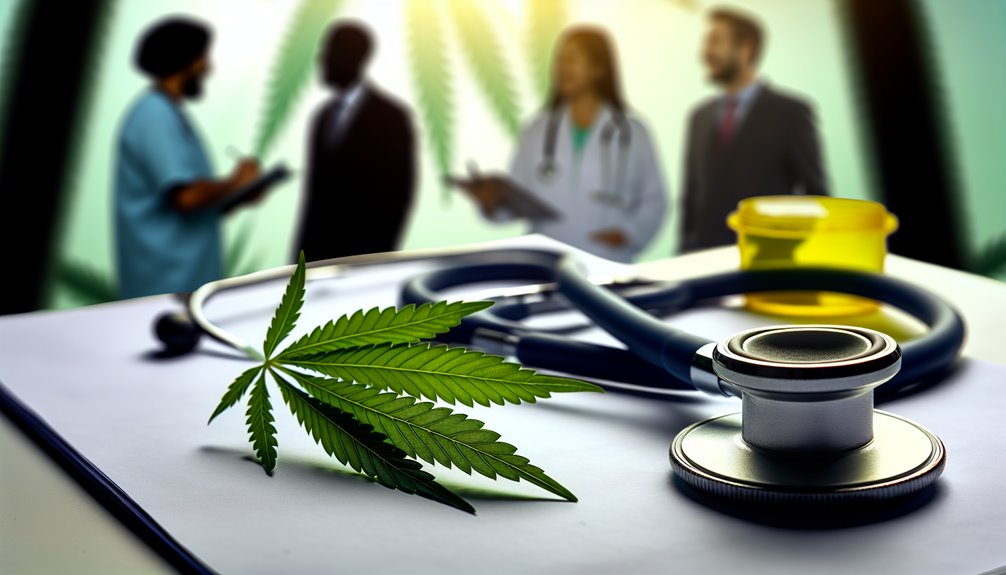Imagine living with a chronic illness and constantly battling pain, sleeplessness, or anxiety. Now, consider medical cannabis as a potential solution. Numerous studies highlight how it can enhance physical health and emotional well-being by over 20%, with 96% of patients reporting reduced symptoms of chronic noncancer pain. Yet, it's important to balance these benefits with potential risks and side effects. Intrigued? Stay with us to explore this promising, yet complex, health alternative.
Understanding Medical Cannabis: Its Components and Functioning

While you may be familiar with the term 'medical cannabis', understanding its components and how they function can provide a deeper insight into its therapeutic potential. The plant contains over 100 identified phytocannabinoids, including Δ9-tetrahydrocannabinol (Δ9-THC) and cannabidiol (CBD), which are most abundant. These components interact with CB1 and CB2 receptors, initiating various signaling pathways that alleviate inflammatory-related diseases. It's the synergy between phytocannabinoids and terpenes that enhances the therapeutic efficacy of medical cannabis, known as the 'entourage effect'. Additionally, phytocannabinoids may bind to the endocannabinoid system (ECS) and/or other receptors. The cannabinoid interactions and therapeutic synergy underline the importance of further research into the potential health benefits of medical cannabis. In several countries, laws have been put in place allowing the use of cannabis-based medicine for various health conditions, including chronic pain, chemotherapy-induced nausea, spasticity in MS, epileptic seizures, depression, and anxiety (legislation).
The Current Legal Status of Medical Cannabis Globally
Building on the understanding of the therapeutic potential of medical cannabis, let's now explore its legal status across the globe. While global legalization is on the rise, regulatory challenges remain.
- Legalization: Nearly 50 countries have fully or partially legalized medical cannabis, including Argentina, Australia, and Canada. However, the rules differ vastly among nations.
- International Treaties: Cannabis is currently classified as a Schedule I drug under the Single Convention treaty, allowing for medical use but acknowledging a potential for abuse.
- Access: Roughly 300 million people live in jurisdictions with regulated cannabis markets. Despite this, accessibility varies greatly. Notably, medical cannabis is legalized in 41 U.S. states, 4 territories, and the District of Columbia, further expanding the potential patient base.
Stay informed about this complex landscape to better serve those that could benefit from medical cannabis. Remember, the legal status is ever-evolving, reflecting society's growing acceptance of its therapeutic potential.
Medical Conditions Potentially Alleviated by Cannabis Use

Given the growing body of evidence, it's clear that medical cannabis can potentially alleviate a range of medical conditions. It's a game-changer for chronic pain management, greatly reducing opioid use and offering relief for conditions like multiple sclerosis and cancer. Neurological disorders also benefit from cannabis use, with promising results in seizure control and spasticity relief. It provides gastrointestinal relief, importantly controlling vomiting in chemotherapy patients and stimulating appetite in HIV/AIDS patients. There's also evidence of its effect on mental health, reducing anxiety and improving sleep quality. However, the THC and CBD balance is vital for sleep improvement. As we continue to explore cannabis's potential, it's important to remember its multifaceted benefits in health-related quality of life.
Exploring the Research: Cannabis and Quality of Life
To explore the research around cannabis and quality of life, numerous studies have shown significant improvements in Health-Related Quality of Life (HRQoL) with medical cannabis use. Here's what the research uncovered:
- Improvements in HRQoL: Cannabis use was linked to more than 20% improvement in physical health, social functioning, and emotional well-being. Patients reported better energy, improved sleep, and enhanced ability to perform duties, highlighting the cannabis effects on quality improvement.
- Reduction in Symptoms: Chronic noncancer pain, the most common reason for cannabis treatment, saw significant reductions. 96% of patients reported decreased symptoms, further improving their quality of life.
- Healthcare Resource Utilization: Cannabis users were less likely to need emergency or hospital care. This reduced strain on healthcare resources indicates potential systemic benefits.
These findings provide evidence that medical cannabis can meaningfully improve HRQoL.
Patient Experiences: Personal Accounts of Cannabis Treatment

While there's ample research supporting the efficacy of medical cannabis in improving Health-Related Quality of Life (HRQoL), it's important to also consider the subjective experiences of patients who've undergone this treatment. Patient testimonials reveal a significant reduction in symptoms like muscle spasms, pain, and nausea. Many also report improvements in their sleep patterns and overall quality of life. Treatment journeys indicate a return to normal activities due to improved health and reduced medication intake. Specific conditions like chronic pain, ALS, and PTSD showed notable improvements under cannabis treatment. High satisfaction rates, extensive treatment options, and professional support highlight the positive patient feedback. These personal accounts provide invaluable insights into the potential of medical cannabis to enhance HRQoL.
The Potential Risks and Side-Effects of Medical Cannabis
Though medical cannabis has demonstrated efficacy in enhancing Health-Related Quality of Life, it's crucial to be mindful of its potential risks and side effects. Your risk assessment should consider:
- Short-term side effects, such as euphoria, impaired memory, and dizziness.
- Long-term risks, including harms linked to smoking, negative effects on attention, and possible addiction.
- Special populations at risk, including pregnant individuals, those with heart disease, and older adults.
Future Directions: Emerging Research and Potential Applications of Medical Cannabis

Despite the potential risks and side effects associated with medical cannabis, its therapeutic potential continues to garner attention in the medical community. You may notice future trends leaning towards innovative therapies as researchers explore cannabinoids' role in managing autoimmune and neurological disorders. Studies are underway to assess medical cannabis's efficacy in reducing chronic pain and enhancing health-related quality of life. Emerging research also suggests its potential in combating specific cancer cells. Real-world data from these studies provide valuable insights for decision-making in medicinal cannabis use. Consequently, while potential risks exist, the future of medical cannabis holds promising possibilities as an adjunctive treatment for various conditions, with the potential to notably improve patients' quality of life.
Conclusion
You've seen the evidence – medical cannabis can greatly enhance life's quality, particularly for those battling chronic pain, neurological disorders, or mental health issues. But remember, it's not a magic bullet. Like all treatments, it carries potential risks. As the saying goes, "Forewarned is forearmed." Stay informed, consult with healthcare professionals, and weigh the pros and cons. The future of medical cannabis appears promising, but let's continue scrutinizing the research.
If you're curious to learn more about how medical cannabis might work for you, I warmly invite you to visit Fells Point Cannabis Docs of Maryland. Our friendly team is here to answer your questions and guide you through the process. You can also give us a call at (410) 401-4200. We're excited to help you explore your options and find the right path for your health and well-being!
